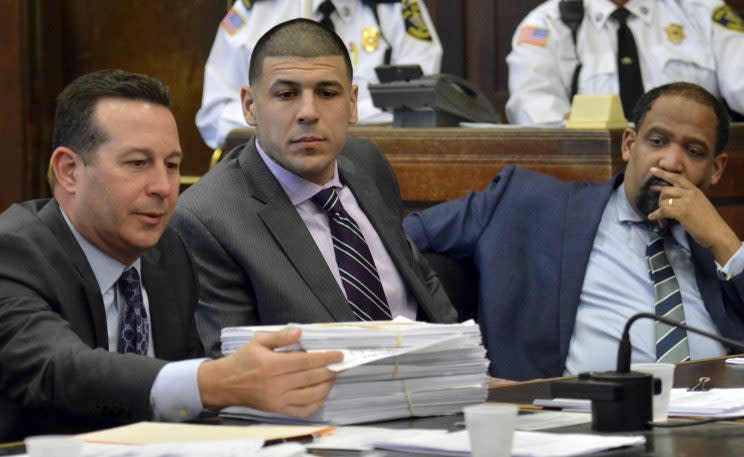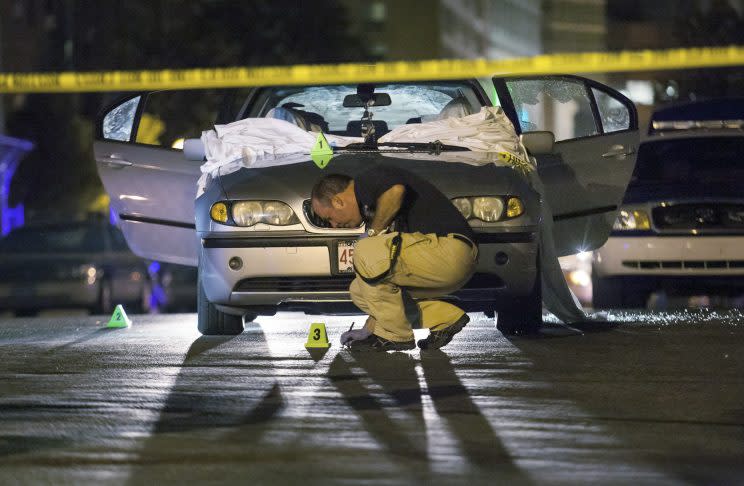Aaron Hernandez's double murder trial: What you need to know
BOSTON — Five months removed from catching a Tom Brady touchdown pass in the Super Bowl, and less than six weeks from finalizing a $40 million contract extension with the New England Patriots, Aaron Hernandez and his friend Alexander Bradley stood in a garage in Manchester, Conn.
It was about 10 p.m. on Sunday, July 15, 2012, and Hernandez wanted to go up to Boston and hit a nightclub. The hour and a half-plus drive meant nothing. Boston was where Hernandez was a star, the big city where they could get ushered into VIP sections and have patrons, particularly women, fawn over him.
Hernandez popped the hood of a Toyota 4Runner a Rhode Island dealer loaned him for free. He slipped a .38-caliber Smith & Wesson into a secret cylinder installed near the engine block. It was a way to conceal a gun, particularly if pulled over by police. It was something out of “The Wire.” The purpose was unclear.
Hernandez had no criminal record, no gang ties and was involved in no outside criminal activities. Growing up in Bristol, Conn., he was raised in a two family home in a town with little to no significant gang activity or even violent crime.
He was, by 2012, a 22-year-old NFL star, headed into a lucrative third season with an again Super Bowl contender. He could have carried a legal weapon in the vehicle. Bradley was a convicted cocaine dealer but was nothing more than a ride along that night. The hidden gun cylinder felt mostly like a guy trying to live a life out of the movies.
This is the beginning of the story Suffolk County prosecutors in Boston will tell to a jury of 12 in the latest murder trial of Aaron Hernandez. It begins Wednesday morning in courtroom 906.
The prosecution’s story will continue like this:
Weapon secured, the hood was dropped and Hernandez and Bradley headed to Boston’s Theatre District. There, inside the Cure Nightclub, Hernandez bumped, literally, into a Cape Verdean immigrant named Daniel de Abreu. Some of Hernandez’s drink was spilled. Abreu, 29, had been a police officer in Cape Verde but was working as a janitor in Boston. He didn’t know Hernandez or much about football. He smiled but didn’t apologize. Hernandez grew enraged. He told Bradley he felt Abreu was “trying him.”
Later, after hitting a couple more clubs, Hernandez was still angry. He and Bradley headed to the Toyota as closing time neared and Hernandez retrieved the weapon from under the hood. They then got in the SUV and circled around the block, looking for Abreu and his party. The hunt was successful, Hernandez spotting them after they left Cure. They ran a nearby red light so they could catch them in pursuit.
The borrowed 2003 BMW Abreu was driving sat innocently at a stoplight down the street where Bradley, now driving, pulled up alongside, Hernandez lowered a window and began firing.
He hit Abreu, 29 in the chest, killing him. He hit passenger Safiro Furtado, 28, another Cape Verdean-born janitor, in the head, killing him as well. Some of the shots went into the backseat, where three stunned and terrified passengers sat. Aquilino Freire was struck twice, in his arms, but survived. Two others barreled out the other door and fled on foot.
Hernandez, out of bullets, kept squeezing the trigger anyway. Soon he slipped onto the Mass Pike and headed back to Connecticut. Detectives in Boston arrived on a scene with few clues and no easy explanation. No one could figure out why the incident had occurred. The idea it might be the Patriots’ star tight end never entered anyone’s mind. Its randomness led to initial suspicions it was just another stupid gang killing, a too frequent occurrence in the city.

This double homicide case comes on top of Hernandez being convicted two years ago for the 2013 murder of Odin Lloyd in North Attleborough, Mass. Hernandez is already serving a life sentence without the possibility of parole for that killing. Massachusetts is not a death penalty state, so while the stakes here are repetitive, the case is being prosecuted to allow justice for the victim’s families.
This case is both simpler than the Lloyd case, but a conviction is hardly certain.
Prosecutors have some challenges, most notably a decided lack of forensic evidence, mostly based on the failure of police to quickly solve the crime. Hernandez wasn’t even considered a suspect until the murder of Lloyd occurred the following summer. That caused a cold case to be reexamined because police knew, from Cure surveillance footage and various tips, that Hernandez was on the scene that night. It took the discovery of the Toyota, stashed in a garage in Connecticut, to connect the dots.
In between allegedly killing Abreu and Furtado and murdering Lloyd, Hernandez played an entire season in the NFL, where he caught five touchdowns in 10 games. He was a possible double murderer in the huddle with no one suspecting a thing.
Then there is the chief witness in the case: Bradley. He’s a convicted criminal himself who is currently serving time in Connecticut for shooting up a nightclub in Hartford.
Bradley is also a victim of Hernandez’s. In February 2013, Hernandez allegedly shot Bradley in the eye in Florida. The two, according to Bradley, were arguing about the bar bill from a night of partying at Tootsie’s Cabaret, a local strip club.

Incensed, Hernandez had the car they were in pulled over, pointed a gun into the backseat where Bradley was and blasted him in the face. Bradley was then thrown out of the car and left to die in an alley near a John Deere dealership (workers there discovered Bradley and called an ambulance). Bradley survived, but lost an eye. He never went to authorities but instead filed a lawsuit in an effort to get Hernandez to pay him off. It became public only after the Lloyd murder. Bradley was also a prosecution witness at that trial.
As witnesses go, Bradley has obvious credibility and motive issues. Those are sure to be exploited by Hernandez’s high-profile defense team, led by Jose Baez, the colorful Florida attorney best known for helping young mother Casey Anthony beat charges that she murdered her child, Caylee, in a high-profile 2011 trial. One theory has the defense arguing that Bradley was the gunman.
Bob McGovern of the Boston Herald pointed out that throughout the jury selection, both sides harped on these two chief issues: lack of forensics and lack of credibility with the star witness. The wrong answer from a prospective juror led to one side or the other striking them.
Additionally, the motive for the murder remains elusive.
Simply, is it believable that a young NFL star with a mega-contract and a baby daughter on the way, truly living the dream, would hunt and kill people he didn’t know, and who posed no threat to him, because of a spilled drink?
That, of course, is part of what makes Hernandez, now 27, such a fascinating killer. His is a double life. He was capable of operating by day within the high levels of professional football and earning the trust of the triumvirate of Patriots leadership – team owner Robert Kraft, coach Bill Belichick and quarterback Tom Brady – while also dabbling in pointless street violence at night. He’s a guy charming enough to be trusted with a free dealer car only to have a secret compartment installed to hide illegal weapons.
He was, police say, involved in no other criminal activity. He was under no threat from anyone. His victim and alleged victims were all unarmed and attacked without warning.
Very little about Hernandez has ever made sense, though. Prosecutors never bothered to offer a motive for why Hernandez killed Lloyd, the happy-go-lucky boyfriend of Hernandez’s fiancée’s sister. Hernandez and his likely future brother-in-law routinely partied and smoke marijuana together. Then Hernandez picked him up and killed him in a field near his home.
Wednesday morning, the prosecution will begin the latest chapter in trying to explain it all – this murder, those actions and the unusual psyche of Aaron Hernandez, who seemed to want to play idiot gangster as much as he did football.
